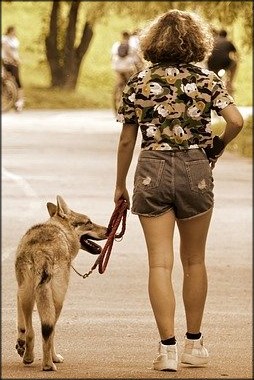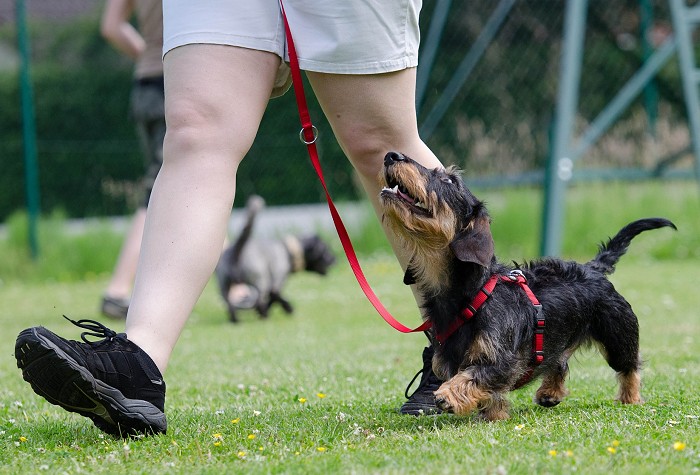Teach your dog to heel (formal walking)
By Michele Welton, Dog Trainer, Breed Selection Consultant, Author of 15 Dog Books
 Heeling means your dog walks at your left side, with his head very close to your left leg. The leash hangs completely loose, forming a big U-shaped loop between your hand and his collar.
Heeling means your dog walks at your left side, with his head very close to your left leg. The leash hangs completely loose, forming a big U-shaped loop between your hand and his collar.
A heeling dog is very attentive to you.
- If you turn to the right or left, a heeling dog will turn with you, maintaining his position close beside your knee.
- If you slow down or speed up, a heeling dog will slow down or speed up, too.
- If you stop walking, a heeling dog will automatically sit beside you and wait for your next move.
A heeling dog is impressive to watch! And for short periods, heeling can be fun for the dog, especially when you make a game out of it – making quick turns, encouraging the dog to maintain his position, and praising him for his attentiveness.

Heeling is a great way for your dog to practice paying attention to you.
Should your dog heel when going for a walk?
No. On a normal walk, although you NEVER allow him to pull on the leash, you do want your pup to have some freedom so he can sniff around a bit, and relieve himself if necessary. You don't want him to be so concerned about maintaining an exact position beside you that he can't even look around at the passing scenery.
But there are times when you need more control over your dog, when in fact you need him to stay very close to you. For example...
- If you need to walk through a crowd of people.
- Or if there is a dog or cat or squirrel nearby.
- Or if your arms are full of groceries and you can't be tripping over a dog walking in front of you or running back and forth from your left side to your right side.
At times like these, "Heel" comes in mighty handy!
Teach your dog to heel
- Before you start to heel, always have your dog sit on your left side. He should be facing the same direction you are, his head close to your left knee (or ankle, for the little guys!). If you always start your heeling by having him sit in Heel Position, he will soon pick up on this clue and be ready to heel.
- Say, "Jake, heel" and take your first heeling step with your LEFT foot. Since your dog is on your left side, if you move your left foot first, he will immediately see it. Then he can rise more quickly from his sit and maintain his position walking beside you.
- Make your first step a small step. This gives him more time to get up and still keep up with you.
- Remember when you taught your dog to walk without pulling on the leash? Well, now you will use the same Loosen-Tug technique, the Sneak-Away game, and the Opposite-Direction game to teach your dog that Heel means he needs to stick closer to your leg than when he was "simply" walking on leash.
In other words, Heeling is a more formal, more precise way of walking.
Teach your dog to SIT when you stop walking
Whenever you stop walking, say, "Sit". If necessary, put slight upward tension (or give a light tug) on the leash. You want him sitting beside your left leg, facing the same direction you are.
If you're consistent about having him sit every time you stop walking, he will eventually sit before you even have a chance to tug the leash or say anything. This is called an automatic sit – very impressive!
Fun heeling patterns
After awhile you'll get bored with walking in a straight line, making an about turn, and walking in another straight line. So....
- Make a 90-degree turn to the left. Continue walking.
- Make a 90-degree turn to the right. Continue walking.
- Walk faster. Break into a trot.
- Walk slower. Take l-o-n-g s-l-o-w steps, dragging out each step so your foot is in the air longer than usual. But don't take slow, short, baby steps or your dog will think you're going to stop and he will keep trying to sit.
- Walk in circles. First large circles, 15 feet across. Then smaller circles, 5 feet across. Circle to the right. Circle to the left.
- Combine two circles into a figure-8 pattern around two posts (or two chairs, two books, two rocks, two orange traffic cones) placed on the ground about eight feet apart.
Heeling is mentally tiring for a dog because it requires so much concentrated focus. Practice for only about 5 minutes at a time.
Heeling on your right side
So you're curious: "Why are dogs usually taught to heel on your LEFT side?"
Most likely this tradition began with hunting dogs and guard dogs, both of whom were taught to walk on the left side so the hunter/soldier could carry his weapon freely in his right hand.
Following this tradition, dogs competing in obedience events always heel on your left side. But for practical, non-competitive purposes, your dog can learn to heel on both sides, as long as you use a different command for each side. For example, if you want to use "Heel" for your left side, then for your right side try a command such as...
"Right Side" (or just "Right")
Start out with your dog heeling on your left side. As you're walking along, say cheerfully, "Jake, RIGHT side!"
Then do the following (review this carefully and practice it a bit, before you try it with your dog!):
To switch your dog from one side to the other, make an about-turn to your LEFT (the opposite direction from your usual about-turn). As you turn, use the leash to guide your DOG into making an about-turn to his RIGHT. In other words, you and your dog are turning toward each other. Then both of you continue heeling in the new direction, except that he's now on your right side!
Here's what it looks like:

In the first image, your dog is heeling on your left. The middle image with the arrows show you making a left about-turn while your dog simultaneously (and with your guidance) makes a right-about-turn. Don't stop walking as you do this!
After you've made this switch, heel with him on your right side for a bit, then say, "Jake, HEEL" and make another dual about-turn, again toward each other. This will put him back on your left side. Again, don't stop walking while you're doing this. Heel with him on your left side for a bit, then switch again.
Most dogs enjoy these quick switches if you make a game out of it – aiming for enthusiasm rather than precision!
My best-selling books – now available FREE on my website
 Respect Training For Puppies: 30 seconds to a calm, polite, well-behaved puppy is for puppies 2 to 18 months old. Your puppy will learn the 21 skills that all family dogs need to know. Click here to read for free.
Respect Training For Puppies: 30 seconds to a calm, polite, well-behaved puppy is for puppies 2 to 18 months old. Your puppy will learn the 21 skills that all family dogs need to know. Click here to read for free. Teach Your Dog 100 English Words is a unique Vocabulary and Respect Training Program that will teach your adult dog to listen to you and do what you say. Click here to read for free.
Teach Your Dog 100 English Words is a unique Vocabulary and Respect Training Program that will teach your adult dog to listen to you and do what you say. Click here to read for free. 11 Things You Must Do Right To Keep Your Dog Healthy and Happy helps your dog live a longer, healthier life. Get my honest advice about all 11 Things before you bring home your new puppy, because some mistakes with early health care cannot be undone. Click here to read for free.
11 Things You Must Do Right To Keep Your Dog Healthy and Happy helps your dog live a longer, healthier life. Get my honest advice about all 11 Things before you bring home your new puppy, because some mistakes with early health care cannot be undone. Click here to read for free.
